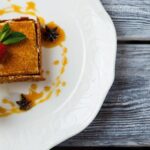Are you looking to take your cake decorating skills to the next level? In this article, we will explore how to use sugar sheets for cake decorating. Sugar sheets are a versatile and convenient way to add intricate designs and patterns to your cakes, making them perfect for both beginners and experienced decorators alike.
Sugar sheets, also known as edible decorating paper or edible icing sheets, are a popular choice for adding detailed designs and images to cakes. They can be used to create a wide variety of decorations, from simple borders and accents to elaborate custom designs. In this article, we will discuss the different types of sugar sheets available and how they can be used to enhance the look of your creations.
In addition to learning about the various applications of sugar sheets, we will also cover the process of preparing the cake surface for sugar sheet application and provide a step-by-step guide on how to apply sugar sheets to a cake. Whether you’re looking to create a sleek modern design or a whimsical pattern, we’ll show you how to achieve professional-looking results with sugar sheets.
Keep reading for tips on troubleshooting common issues that may arise when using sugar sheets as well as enhancing the look of your cake with additional accents and embellishments.
Understanding the Different Types of Sugar Sheets and Their Applications
Sugar sheets come in a variety of types and each has its own unique application in cake decorating. The most common types of sugar sheets include edible wafer paper, fondant sheets, and edible fabric sheets. Each of these types has distinct properties that make them suitable for different decorating techniques.
Edible wafer paper is thin and flexible, making it ideal for creating delicate decorations such as flowers, leaves, and intricate cut-out designs. Fondant sheets, on the other hand, are thicker and more pliable, making them perfect for covering the entire surface of a cake or creating 3D decorations. Lastly, edible fabric sheets have a soft, fabric-like texture that can be used to create ruffles, bows, and other fabric-inspired decorations.
When choosing the right type of sugar sheet for your cake decorating project, consider the desired design and the specific techniques you plan to use. Edible wafer paper works well for detailed designs that require precision cutting, while fondant sheets are better suited for larger surfaces or sculpted decorations. Edible fabric sheets add a unique touch to any cake design with their soft and elegant look.
Understanding the different types of sugar sheets and their applications is crucial for achieving professional-looking cake decorations. Whether you want to create intricate designs with edible wafer paper or cover an entire cake with fondant sheets, knowing how to use sugar sheets for cake decorating will take your creations to the next level.
Preparing the Cake Surface for Sugar Sheet Application
When it comes to decorating a cake with sugar sheets, proper preparation of the cake surface is essential to ensure a smooth and professional-looking finish. By taking the time to prepare the cake surface correctly, you can prevent wrinkles, air bubbles, and other common issues that may arise during the application process.
Choosing the Right Cake Base
Before applying sugar sheets to a cake, it is important to start with a smooth and even cake base. Whether you are using a homemade or store-bought cake, make sure that it is level and free from any lumps or bumps. If necessary, trim the top of the cake to create a flat surface for the sugar sheet application.
Applying a Thin Layer of Frosting
To ensure that the sugar sheet adheres properly to the cake, it is recommended to apply a thin layer of frosting or icing to the entire surface of the cake. This will create a smooth and slightly tacky surface for the sugar sheet to stick to. Be sure not to apply too much frosting, as this can cause air bubbles and wrinkles in the sugar sheet.
Keeping It Moist
Once the frosting is applied, it’s important to work relatively quickly when applying sugar sheets. If too much time passes between frosting application and sugar sheet placement, the frosting may dry out, making it difficult for the sugar sheet to adhere properly. Keep your prepared cake covered with plastic wrap until you are ready to apply the sugar sheet.
By following these steps for preparing the cake surface for sugar sheet application, you can set yourself up for success in creating beautifully decorated cakes using this versatile decorating medium. With careful preparation and attention to detail, you can achieve professional-looking results when using sugar sheets for cake decorating purposes.
Applying Sugar Sheets to a Cake
Step 1: Prepare Your Sugar Sheet
Before applying the sugar sheet to your cake, make sure it is at room temperature. If the sugar sheet is too cold, it may crack or tear when you try to work with it. Gently knead the sugar sheet to help soften it and make it more pliable. If you plan to use multiple colors of sugar sheets for your design, now is the time to cut out any shapes or patterns that you will be layering.
Step 2: Prepare Your Cake
Ensure that the surface of your cake is clean and free from any crumbs or debris. You can lightly brush the top and sides of the cake with a thin layer of piping gel or edible glue. This will provide a slightly tacky surface for the sugar sheet to adhere to.
Step 3: Apply the Sugar Sheet
Carefully lift and position the sugar sheet over the cake. Gently smooth out any air bubbles as you press the sugar sheet onto the cake’s surface using a fondant smoother or your hands. Trim off any excess sugar sheet around the base of the cake using a sharp knife or pair of scissors. If there are any seams where two pieces of sugar sheet meet, use a small amount of water to “glue” them together.
By following these steps, you can easily and effectively apply a beautiful sugar sheet design to your cake. Mastering this technique allows for endless possibilities in creating stunning and professional-looking cakes. With practice and creativity, using sugar sheets for cake decorating can take your confectionery skills to new heights.
Creating Intricate Designs and Patterns With Sugar Sheets
Sugar sheets are a versatile and convenient way to add stunning designs and patterns to your cakes. With a little creativity and the right techniques, you can achieve intricate and beautiful decorations that will impress anyone who sees your creations. Here’s how to use sugar sheets for cake decorating to create intricate designs and patterns:
1. Choose the Right Tools: Before you start working with sugar sheets, make sure you have the necessary tools on hand. This includes a sharp pair of scissors for cutting the sheets, as well as various decorating tools such as embossers, cutters, and impression mats to create different textures and designs.
2. Select Your Design: Decide on the design or pattern you want to create on your cake with sugar sheets. Whether it’s floral motifs, geometric patterns, or even personalized messages, having a clear idea of what you want to achieve will help guide your process.
3. Cut and Shape the Sugar Sheets: Use your scissors or cutting tools to carefully cut out the shapes and designs from the sugar sheets. You can also use punches or stencils for more precise shapes. Once cut, shape the sugar sheets by gently bending them into curves or folds if needed.
4. Apply the Designs: Carefully place the sugar sheet designs onto your cake, smoothing them out gently to ensure they adhere properly to the surface. You can overlap different pieces of sugar sheet if you’re creating a larger design, or mix and match colors for added visual interest.
5. Finishing Touches: Once your designs are in place, add any additional embellishments or accents using other decorative elements like fondant, edible paints, or piping gel to enhance the overall look of your cake.
By following these steps and using some creativity, you can elevate your cake decorating skills by incorporating intricate designs and patterns with sugar sheets. Whether you’re a beginner or an experienced baker, mastering this technique will open up a world of possibilities for creating visually stunning cakes that are sure to be a hit at any event.
Troubleshooting Common Issues When Using Sugar Sheets
Even with the best preparation and careful application, cake decorators may encounter some common issues when using sugar sheets for cake decorating. It is important to be aware of these potential problems and how to troubleshoot them effectively.
One common issue that decorators may encounter is the sugar sheet cracking or tearing during application. This can happen if the sheets are too dry or have been exposed to excess heat or humidity.
To prevent this issue, it is important to store the sugar sheets in a cool, dry place and work in a comfortable room temperature environment. If tearing does occur, it may be possible to carefully smooth out the tear with a small amount of water using a clean brush.
Another issue that can arise is air bubbles forming between the sugar sheet and the cake surface. Air bubbles can cause an uneven appearance and affect the overall finish of the cake design. To avoid this problem, decorators should use a smoother tool to gently press out any air bubbles as they apply the sugar sheet to the cake. If air bubbles still appear, a small pinprick can help release trapped air and allow for a smoother finish.
Additionally, some decorators may find it challenging to remove excess icing or frosting from their hands while handling sugar sheets, leading to smudges or fingerprints on the delicate surface. To prevent this issue, it can be helpful to keep a bowl of water and a clean towel nearby for quick hand cleaning between handling different parts of the sugar sheet.
Overall, being aware of these common troubleshooting issues and knowing how to address them will help decorators achieve beautiful and professional-looking results when using sugar sheets for cake decorating.
| Common Issue | Troubleshooting Solution |
|---|---|
| Sugar sheet tearing/cracking | Store in cool, dry place; smooth tear with water |
| Air bubbles forming | Use smoother tool; release trapped air with pinprick |
| Excess icing/frosting on hands | Maintain bowl of water and clean towel for hand cleaning |
Enhancing the Look of a Cake With Sugar Sheet Accents and Embellishments
When it comes to cake decorating, sugar sheets offer a versatile and convenient way to add beautiful accents and embellishments to your creations. Whether you’re looking to create intricate designs, colorful patterns, or personalized messages, sugar sheets can elevate the look of any cake. In this section, we’ll explore how to use sugar sheets for cake decorating and discuss various techniques for enhancing the visual appeal of your cakes.
One of the most popular ways to use sugar sheets for cake embellishments is by cutting them into different shapes and designs. With the help of cookie cutters or stencils, you can create flowers, leaves, stars, or any other shape you desire. These cut-out sugar sheet decorations can then be applied directly onto the frosted surface of the cake. Additionally, you can layer different colored sugar sheets to create stunning 3D effects on your cakes.
Another method for enhancing the look of a cake with sugar sheet accents is by embossing or imprinting patterns onto the sheets before applying them to the cake. This technique allows you to add texture and dimension to your designs, resulting in visually striking decorations. Using embossing tools or textured rollers, you can imprint intricate lace patterns, geometric shapes, or even realistic textures such as wood grain or stone onto the sugar sheets before adhering them to the cake.
Finally, adding edible glitter, metallic paints, or luster dust to your sugar sheet decorations can take them to the next level. These shimmering accents can bring a touch of elegance and sophistication to your cakes, making them perfect for special occasions like weddings or anniversaries.
| Technique | Description |
|---|---|
| Cutting Shapes | Create various shapes using cookie cutters or stencils. |
| Embossing/Imprinting | Add texture and dimension by embossing or imprinting patterns onto sugar sheets. |
| Adding Accents | Enhance decorations with edible glitter, metallic paints, or luster dust for an elegant touch. |
Tips and Tricks for Getting the Best Results With Sugar Sheets
Sugar sheets are a versatile and convenient tool for cake decorating, allowing decorators to create intricate designs and patterns with ease. However, getting the best results with sugar sheets requires some know-how and practice. Here are some tips and tricks for using sugar sheets effectively:
1. Use a sharp blade or scissors: When cutting out shapes or designs from the sugar sheet, it’s important to use a sharp blade or scissors to ensure clean, precise edges. Dull blades can cause tearing or jagged edges, so make sure your cutting tools are in top condition.
2. Work on a smooth, dry surface: Before applying the sugar sheet to the cake, make sure the surface is smooth and dry. Any moisture on the cake can cause the sugar sheet to dissolve or become sticky, making it difficult to work with. You can also lightly dust the cake surface with powdered sugar to absorb any excess moisture.
3. Store unused sugar sheets properly: To prevent sugar sheets from drying out and becoming brittle, store them in a resealable plastic bag or airtight container at room temperature. Avoid exposing them to direct sunlight or extreme heat, as this can cause them to warp or lose their flexibility.
4. Experiment with different techniques: Don’t be afraid to experiment with different techniques for using sugar sheets, such as layering colors, embossing texture, or combining them with other decorating elements like fondant or royal icing. This will help you discover new ways to create stunning designs and decorations for your cakes.
By following these tips and tricks, you can master the art of using sugar sheets for cake decorating and create beautiful, professional-looking cakes that are sure to impress. Whether you’re a beginner or an experienced decorator, understanding how to use sugar sheets effectively can take your cake decorating skills to the next level.
Conclusion
In conclusion, mastering the art of cake decorating with sugar sheets can truly elevate your baking game. As discussed in this article, sugar sheets offer a convenient and versatile option for creating stunning designs and patterns on your cakes. By understanding the different types of sugar sheets, preparing the cake surface properly, and following a step-by-step guide for application, you can achieve professional-looking results.
The key to using sugar sheets for cake decorating lies in practice and experimentation. Don’t be afraid to try out different techniques and designs to see what works best for you. With some patience and creativity, you can create intricate and elaborate designs that will impress your friends, family, or clients.
Ultimately, using sugar sheets for cake decorating is a skill that can be honed over time. By carefully troubleshooting common issues, exploring different ways to enhance the look of your cakes with accents and embellishments, and incorporating tips and tricks for the best results, you’ll be well on your way to becoming a master at using sugar sheets for cake decorating.
So go ahead, get creative with your cakes, and enjoy the process of experimenting with this unique and exciting cake decorating technique.
Frequently Asked Questions
How Do You Use Sugar Sheets on a Cake?
Using sugar sheets on a cake is quite simple. First, you need to cut the sugar sheet to the desired size and shape. Then, gently lay the sheet onto the frosted cake and smooth it out to remove any air bubbles.
How Long Will Sugar Sheets Last on a Cake?
Sugar sheets can last on a cake for quite some time, especially if the cake is stored in a cool, dry place. If stored properly, sugar sheets can last for several days without losing their shape or color.
What Is the Difference Between Frosting Sheets and Sugar Sheets?
The main difference between frosting sheets and sugar sheets lies in their ingredients. Frosting sheets are made from compressed icing and have a slightly softer texture, while sugar sheets are made from edible paper with a firm consistency. Depending on the desired effect for your cake, you may choose one over the other based on your specific needs.

Welcome to my blog about home and family. This blog is a place where I will share my thoughts, ideas, and experiences related to these important topics. I am a stay-at-home mom with two young children. I hope you enjoy reading it! and may find some helpful tips and ideas that will make your home and family life even better!





